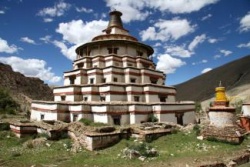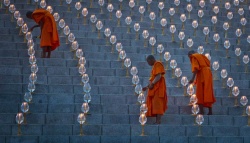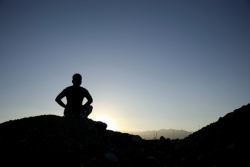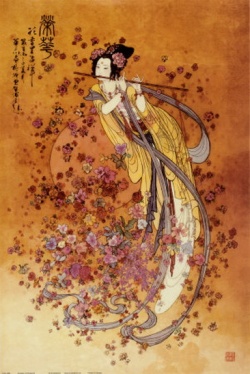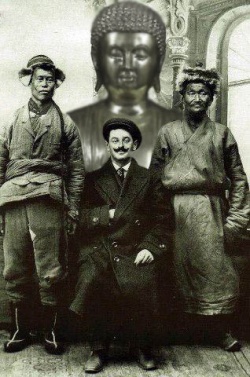Stupa of Jonang
The book was of special interest to me because Dölpopa Sherab Gyaltsen was one of the most famous residents of Jonang Monastery in Tibet, which I had the pleasure of visiting when I was doing research on Zanabazar, the First Bogd Gegeen of Mongolia.
Taranatha (1575–1634), the Previous Incarnation of Zanabazar, founded the monastery of Takten Damchö Ling not from Dölpopa’s Jonang Monastery and Zanabazar almost certainly visited both sites during his Visits to Tibet.
Dölpopa Sherab Gyaltsen (དོལ་པོ་པ་ཤེས་རབ་རྒྱལ་མཚན་; Döl-po-pa Shes-rab Rgyal-mtshan) was born in 1292 in the Dölpo region of what is now Nepal.
He is more commonly known simply as Dölpopa, the “Man from Dölpo”.
He was the founder of the Jonang Sect, later suppressed by the more politically powerful Gelug Sect to which the Dalai Lamas have belonged.
He was also the first major proponent of the so-called Shentong View, an important stream of Tibetan philosophical thought which continues to have staunch adherents down to the Present Day:
"Zhentong," (gzhan stong, "shentong") "extrinsic emptiness" or "other-emptiness" is a view of how the ultimate nature of reality is free from or empty of everything "other" than its absolute nature.
In other words, a zhentong view understands how one's own enlightened essence is empty of everything false in superficial relative reality.
Zhentong as a view for meditation practice regards relative reality as empty of its own intrinsic existence.
This emptiness of inherent substance or "rangtong" is considered to be solely the nature of relative reality while ultimate reality is understood to be empty of everything other than itself.
Accordingly, transient tangible experiences remain devoid of inherent substance as the boundless luminous nucleus of Buddhahood within all beings remains intangible and invariant.
The meditation caves in the cliffs above Jonang Monastery were reportedly used by Padmasambhava, the 8th century Nyingma master who introduced tantric Buddhism from India into Tibet.
A monastery was flourishing on the site by the time Dölpopa arrived there for the first time in 1321.
In 1326 he was officially installed as the head of the monastery, taking the place of Yönton Gyatso, who had also been Dölpopa’s teacher.
A year later Yönton Gyatso transmigrated. In his honor Dölpopa decided to built an enormous stupa.
The first attempt in 1329 failed when the entire structure collapsed during construction.
Undaunted, he began construction of an even bigger stupa on a different site.
As word of the project spread artisans and laborers from all parts of Tibet flocked to the site and soon donations of gold, silver, copper, tea, silk, and much else poured in from all over the Tibetan Buddhist world.
More on the Great Stupa.
The design of the stupa was based on descriptions of the Glorious Stupa of the Planets given in the Stainless Light, a commentary on the Kalachakra Tantra, which according to legend had first been expounded by the Buddha himself.
(As you may know the current Dalai Lama is giving a Kalachakra Initiation in Washington, DC, July 6–16, 2011.) According to tradition, the Stainless Light had been written by Pundarika, the Second Kalkin King of Shambhala.
Dölpopa apparently believed that he was a reincarnation of Pundarika and claimed to have visited Shambhala by visionary means.
On the hillside above the stupa can be seen Dölpopa’s personal residence, known as Dewachen.
Above Dewachen can be seen meditation huts and openings to caves, perhaps the meditation caves used by Padmasambhava.
When Tsarchen Losel Gyatso, one of the great Sakya sect tantric masters of the sixteenth century and also a follower of various Jonang tenets, visited Jonang in 1539, he noted:
he next morning we visited the great Stupa That Liberates on Sight, the temple of the lineage of the Six-branch Yoga, and so forth.
When I gazed from afar at the hermitages, my mind went out to them and I was enthralled.
A distinctly vivid pure vision dawned in the center of my heart and I thought, “The early excellent masters established a continuous meditation center on a site such as this.
Placing many people on the path of liberation, their way of life was so amazing and incredible. When will we also practice for enlightenment in an isolated site such as this?”
